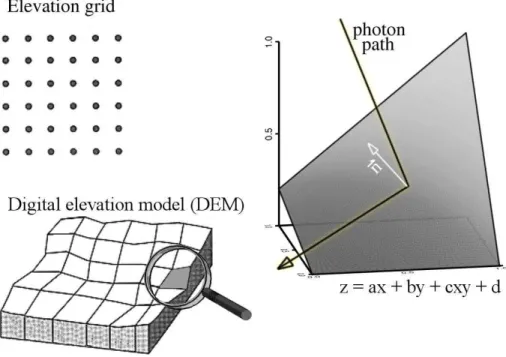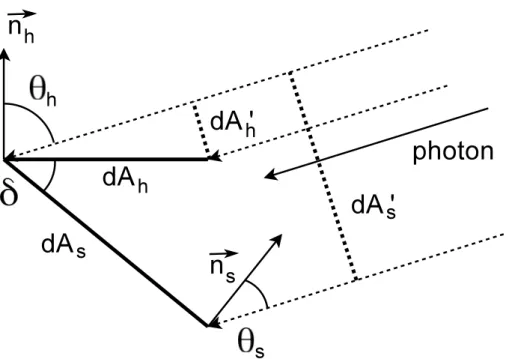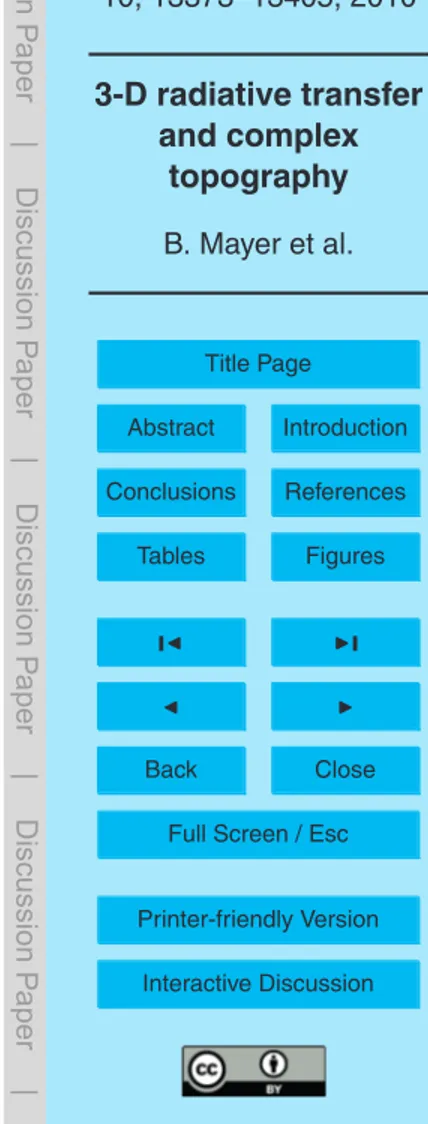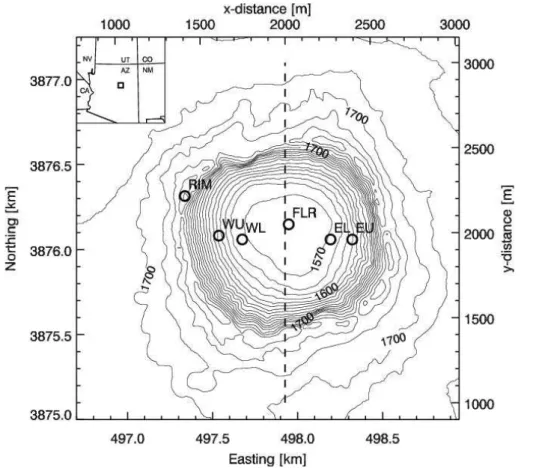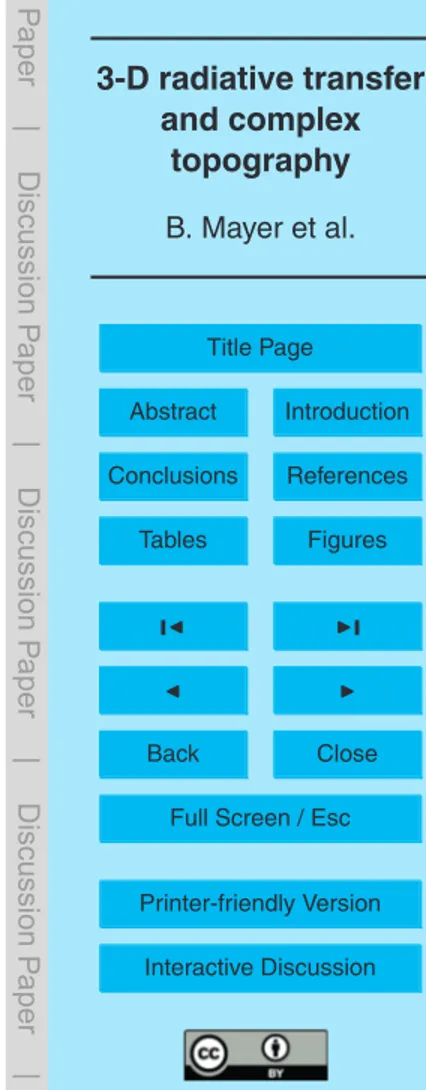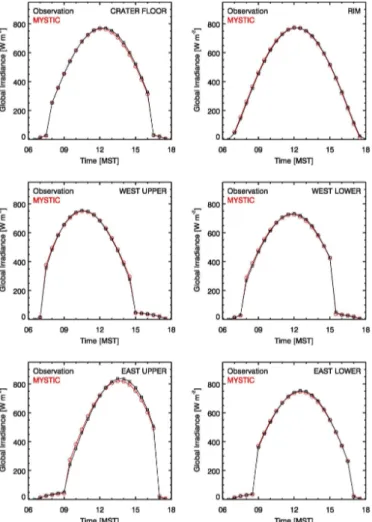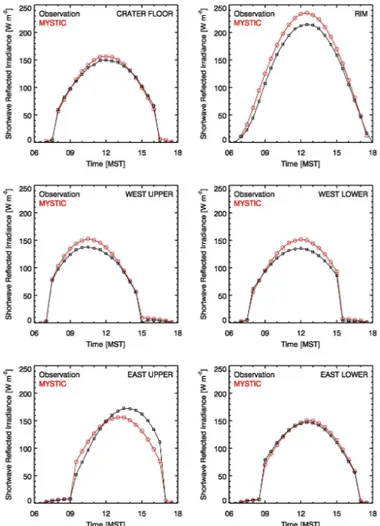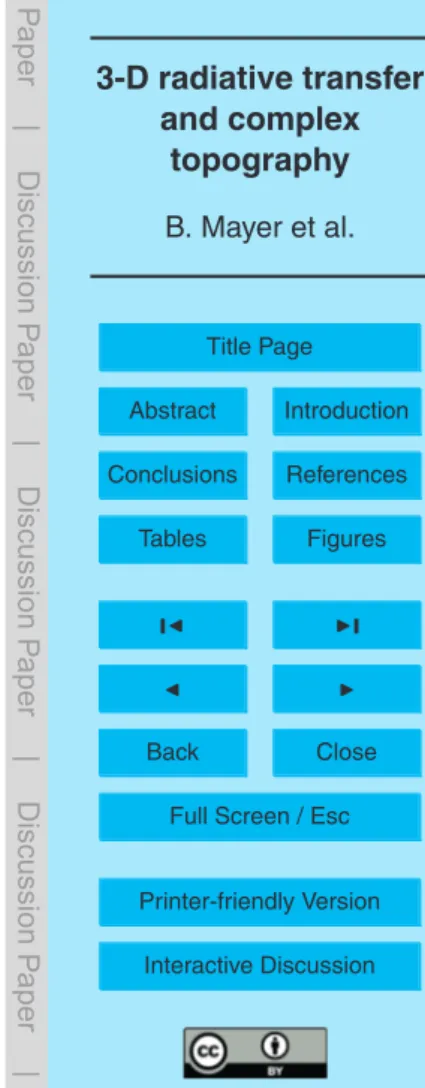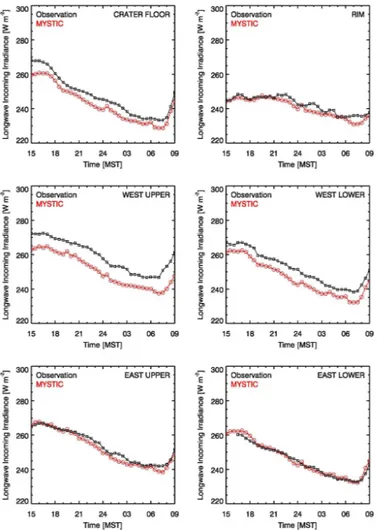ACPD
10, 13373–13405, 2010 3-D radiative transfer
and complex topography B. Mayer et al.
Title Page
Abstract Introduction
Conclusions References
Tables Figures
◭ ◮
◭ ◮
Back Close
Full Screen / Esc
Printer-friendly Version
Interactive Discussion
Discussion
P
a
per
|
Dis
cussion
P
a
per
|
Discussion
P
a
per
|
Discussio
n
P
a
per
|
Atmos. Chem. Phys. Discuss., 10, 13373–13405, 2010 www.atmos-chem-phys-discuss.net/10/13373/2010/ doi:10.5194/acpd-10-13373-2010
© Author(s) 2010. CC Attribution 3.0 License.
Atmospheric Chemistry and Physics Discussions
This discussion paper is/has been under review for the journal Atmospheric Chemistry and Physics (ACP). Please refer to the corresponding final paper in ACP if available.
Validating the MYSTIC three-dimensional
radiative transfer model with
observations from the complex
topography of Arizona’s Meteor Crater
B. Mayer1,3, S. W. Hoch2, and C. D. Whiteman2
1
Meteorological Institute, Ludwig-Maximilians-University, Munich, Germany
2
University of Utah, Salt Lake City, Utah, USA
3
also at: Deutsches Zentrum f ¨ur Luft- und Raumfahrt (DLR), Oberpfaffenhofen, Germany Received: 18 April 2010 – Accepted: 17 May 2010 – Published: 26 May 2010
Correspondence to: B. Mayer (bernhard.mayer@lmu.de)
ACPD
10, 13373–13405, 2010 3-D radiative transfer
and complex topography B. Mayer et al.
Title Page
Abstract Introduction
Conclusions References
Tables Figures
◭ ◮
◭ ◮
Back Close
Full Screen / Esc
Printer-friendly Version
Interactive Discussion
Discussion
P
a
per
|
Dis
cussion
P
a
per
|
Discussion
P
a
per
|
Discussio
n
P
a
per
|
Abstract
The MYSTIC three-dimensional Monte-Carlo radiative transfer model has been ex-tended to simulate solar and thermal irradiances with a rigorous consideration of topog-raphy. Forward as well as backward Monte Carlo simulations are possible for arbitrarily oriented surfaces and we demonstrate that the backward Monte Carlo technique is
5
superior to the forward method for applications involving topography, by greatly reduc-ing the computational demands. MYSTIC is used to simulate the short- and longwave radiation fields during a clear day and night in and around Arizona’s Meteor Crater, a bowl-shaped, 165-m-deep basin with a diameter of 1200 m. The simulations are made over a 4 by 4 km domain using a 10-m horizontal resolution digital elevation
10
model and meteorological input data collected during the METCRAX (Meteor Crater Experiment) field experiment in 2006. Irradiance (or radiative flux) measurements at multiple locations inside the crater are then used to evaluate the simulations. MYSTIC is shown to realistically model the complex interactions between topography and the radiative field, resolving the effects of terrain shading, terrain exposure, and longwave
15
surface emissions. The effects of surface temperature variations and of temperature stratification within the crater atmosphere on the near-surface longwave irradiance are then evaluated with additional simulations.
1 Introduction
Spatial variations in surface radiation and energy budgets within complex topography
20
often produce a complex mosaic of different microclimates. The radiative energy ex-change that plays the important role in producing these microclimates is complicated by the complex earth-atmosphere interface introduced by realistic topography and vary-ing surface properties. Topographic effects such as terrain shading, terrain exposure (slope angle and azimuth of terrain), and terrain reflections greatly affect the
short-25
ACPD
10, 13373–13405, 2010 3-D radiative transfer
and complex topography B. Mayer et al.
Title Page
Abstract Introduction
Conclusions References
Tables Figures
◭ ◮
◭ ◮
Back Close
Full Screen / Esc
Printer-friendly Version
Interactive Discussion
Discussion
P
a
per
|
Dis
cussion
P
a
per
|
Discussion
P
a
per
|
Discussio
n
P
a
per
|
from higher surrounding terrain and by the blocking of outgoing radiation. Traditional radiative transfer models, assuming homogeneous flat surfaces, are not capable of re-producing the complex topographic variations of the radiative fluxes observed in three dimensional terrain with varying surface properties (Whiteman et al., 1989; Matzinger et al., 2003; Hoch and Whiteman, 2010). In recent years, 3-D radiative transfer models
5
based on Monte Carlo photon tracing techniques have been developed to model radia-tive transfer in inhomogeneous cloudy atmospheres. Some of these include also topog-raphy, although mainly for the solar spectral range, (e.g., Weihs et al., 2000; Kylling and Mayer, 2001; M ¨uller and Scherer, 2005; Chen et al., 2006; Helbig et al., 2009). For this study we implemented topography for the calculation of solar and thermal irradiance
10
and radiance into MYSTIC (Monte Carlo code for the physically correct tracing of pho-tons in cloudy atmospheres) (Mayer, 2009; Emde and Mayer, 2007). A mathematically rigorous formulation was used in forward and backward Monte Carlo mode. The model is described in Sect. 2. Appendices are provided to document features of the model that are relevant to its use in accurately representing three-dimensional topography.
15
We then applied MYSTIC to simulate radiative transfer within the three-dimensional topography of Arizona’s Meteor Crater using measured meteorological inputs and to-pography data. The simulations are tested against irradiance measurements made within the crater during the METCRAX 2006 meteorological experiment (Whiteman et al., 2008). The tests show that MYSTIC realistically models the complex interactions
20
between topography and the radiative field, resolving the effects of terrain shading, ter-rain exposure, and longwave surface emissions. Following the successful evaluation of the model, the model is used in a parametric study to investigate the role of surface-air temperature discontinuities and temperature stratification on the longwave irradiance in the crater topography.
ACPD
10, 13373–13405, 2010 3-D radiative transfer
and complex topography B. Mayer et al.
Title Page
Abstract Introduction
Conclusions References
Tables Figures
◭ ◮
◭ ◮
Back Close
Full Screen / Esc
Printer-friendly Version
Interactive Discussion
Discussion
P
a
per
|
Dis
cussion
P
a
per
|
Discussion
P
a
per
|
Discussio
n
P
a
per
|
2 The 3-D radiative transfer model MYSTIC
MYSTIC is capable of radiative transfer calculations in three-dimensional atmospheres in plane-parallel and spherical geometry (Mayer, 2009; Emde and Mayer, 2007; Kylling and Mayer, 2001). The model, developed as a solver for the freely available libRad-tran (Mayer and Kylling, 2005) radiative libRad-transfer package handles three-dimensional
5
clouds, inhomogeneous surface albedo, and topography. The accuracy of MYSTIC was demonstrated previously by comparison with the one-dimensional DISORT code (Stamnes et al., 1988) and with other three-dimensional solvers during the I3RC (inter-comparison of 3-D radiation codes) campaign, where deviations of less than 1% were found for well-defined conditions (Cahalan et al., 2005). Experimental validation of 3-D
10
radiative transfer codes is very difficult in general: pronounced 3-D atmospheric effects on radiation are usually found only in cloudy cases, and the three-dimensional classifi-cation of clouds is a complex task. Usually, the uncertainty in the cloud structure used as input to the calculation is known only with large uncertainty and the comparison between the simulated and measured radiation does not allow firm conclusions to be
15
drawn concerning the accuracy of the model. Nevertheless, a comparison of observa-tions and calculaobserva-tions during a total solar eclipse has shown that MYSTIC compares very well with observations also for three-dimensional setups (Emde and Mayer, 2007; Kazantzidis et al., 2007).
MYSTIC has recently been described in detail by Mayer (2009). Here we
concen-20
trate on the specific requirements for use of topography as a lower boundary condition in the model. In our case, elevation is specified on a rectangular grid with constant grid spacingdx and d y in x- andy-directions. Between the grid points, elevation is interpolated bi-linearly (see Fig. 1):
z(x,y)=ax+by+cxy+d , (1)
25
ACPD
10, 13373–13405, 2010 3-D radiative transfer
and complex topography B. Mayer et al.
Title Page
Abstract Introduction
Conclusions References
Tables Figures
◭ ◮
◭ ◮
Back Close
Full Screen / Esc
Printer-friendly Version
Interactive Discussion
Discussion
P
a
per
|
Dis
cussion
P
a
per
|
Discussion
P
a
per
|
Discussio
n
P
a
per
|
this non-plane parameterization, one could have split each grid cell into two plane triangles). With this description, reflection at slopes can be accurately simulated. As in any regular MYSTIC run, photons are traced from scattering to scattering where the jump width is sampled from Lambert-Beer’s law. At the end of each path element the photon altitude is checked to see if it is below the highest surface altitude. If it is, the
5
last photon path element is re-traced to determine whether the photon intersects the surface in any of the elevation grid cells along the photon path (Appendix A describes a numerically stable calculation of the intersection point). If an intersection is found, the photon is reflected according to the surface properties at the intersection point. Currently Lambertian reflection is assumed. Non-Lambertian bidirectional reflectance
10
distribution functions (BRDFs) would be possible as well, but we are not aware of any BRDF data extending to polar angles larger than 90◦ which are needed when a photon is reflected down-slope. Reflection is determined by a random process: if a random number between 0 and 1 is smaller than the surface albedo, the photon is reflected and a new random photon direction is chosen; otherwise the photon path
15
ends. Alternatively, the photon may be reflected always while multiplying the photon weight with the surface albedo. Which of those methods is more efficient depends on the application.
At the surface we have to distinguish between slope-parallel and horizontal irradi-ance,Es and Eh. The slope-parallel irradiance is the radiant flux on the sloped area
20
divided by the surface area and describes the actual energy flux received by the sur-face. While this is the correct quantity for energy budget considerations, instruments often observe the horizontal irradiance, that is, the radiant flux on a horizontal surface divided by the horizontal surface area.
By counting of all photons received by the sloped surface we obtain the slope-parallel
25
irradianceEs. In particular,
Es= Q
As
= 1
As
E0cosθ0Ad
N0
X
i
ACPD
10, 13373–13405, 2010 3-D radiative transfer
and complex topography B. Mayer et al.
Title Page
Abstract Introduction
Conclusions References
Tables Figures
◭ ◮
◭ ◮
Back Close
Full Screen / Esc
Printer-friendly Version
Interactive Discussion
Discussion
P
a
per
|
Dis
cussion
P
a
per
|
Discussion
P
a
per
|
Discussio
n
P
a
per
|
whereE0is the extraterrestrial irradiance, cosθ0is the cosine of the solar zenith angle
which corrects for the slant incidence at top-of-atmosphere,Adis the area of the total
model domain, and N0 is the total number of photons traced.
E0cosθ0Ad
N0 is thus the
radiant flux associated to the individual photon incident at TOA. By counting the weights
wi of all photons reaching the respective surface pixel and dividing by the surface area
5
Asof the sample pixel we finally obtain the slope-parallel irradianceEs. For our bi-linear
description of the surface, the calculation of the surface areaAs turns out to be rather
complex and is described in Appendix B.
The calculation of the horizontal irradiance Eh is a bit more complicated: for each
photon we need to consider the probability that the photon had actually not hit the
10
sloped surface but the horizontal surface. Figure 2 illustrates what needs to be done: to consider that the photon would have hit surface elementd Ahinstead ofd Aswe need
to multiply the photon weight with the ratio of the projected areas
d A′h d A′s
=d Ahcosθh
d Ascosθs
=cosθhcosδ
cosθs
(3)
(usingd Ah=d Ascosδ). We finally obtain for the horizontal irradiance
15
Eh=
Q As
= 1
As
E0cosθ0Ad
N0
X
i ,θh,i<90◦
wicosθh,icosδi
cosθs,i
(4)
Please note the indexi atθh,i,θs,i, and δi which indicates that all three angles differ
from photon to photon because the slope varies over each pixel. Theθh,i<90◦ under
the sum indicates that only photons with incident angles<90◦ (“coming from above”) are counted into the downward irradiance.
20
While these angles are easily calculated by simple geometry, such a pre-factor may cause problems in terms of numerical noise. In particular the factor 1/cosθs,i may
ACPD
10, 13373–13405, 2010 3-D radiative transfer
and complex topography B. Mayer et al.
Title Page
Abstract Introduction
Conclusions References
Tables Figures
◭ ◮
◭ ◮
Back Close
Full Screen / Esc
Printer-friendly Version
Interactive Discussion
Discussion
P
a
per
|
Dis
cussion
P
a
per
|
Discussion
P
a
per
|
Discussio
n
P
a
per
|
This is a strong motivation for using the backward Monte Carlo technique where the photons are started from the detector and traced backwards through the atmosphere towards the sun or the point where they are emitted thermally, see e.g., Emde and Mayer (2007). Please note that in the following we discuss only the diffuse irradiance component. The direct irradiance is easily evaluated by Lambert-Beer’s law.
5
Backward horizontal irradianceEhis calculated exactly as without topography:
pho-tons are either emitted from a point location or from a random location within a given sample pixel, if the average over a certain area is desired as in the forward calculation. The photons are emitted at the surface elevation, into a random upward direction with a probability proportional to the cosine of the polar angleθh. Please note that some of
10
the thus emitted photons immediately hit the slope and are reflected or absorbed ac-cordingly. Slope-parallel irradiance needs some special attention: After selection of the start location (distributed randomly in the horizontal) each photon is assigned a start weight of cosδi where δi is the local slope angle, see Fig. 2. This (a) accounts for
the fact that actually more photons start at steeper slopes which actually have a larger
15
surface area; and (b) makes sure that surface-parallel irradiance relates to the sloped surface rather than to the horizontal surface. Photons are started in a random outward direction with a probability proportional to the cosine of the polar angle θs. Forward
and backward irradiances calculated by MYSTIC generally agreed to much better than 1% and in all cases within the Monte Carlo photon noise.
20
Figure 3 illustrates that backward Monte Carlo is the method of choice for irradi-ance calculations with topography. The upper plot shows the results of 10 000 indi-vidual MYSTIC calculations with 1000 photons each. For this purpose, the cloudless US standard atmosphere (Anderson et al., 1986) was chosen. Spectral irradiance was calculated at 320 nm for solar zenith angle 60◦for a 2-D mountain with triangular shape
25
ACPD
10, 13373–13405, 2010 3-D radiative transfer
and complex topography B. Mayer et al.
Title Page
Abstract Introduction
Conclusions References
Tables Figures
◭ ◮
◭ ◮
Back Close
Full Screen / Esc
Printer-friendly Version
Interactive Discussion
Discussion
P
a
per
|
Dis
cussion
P
a
per
|
Discussion
P
a
per
|
Discussio
n
P
a
per
|
caused by the 1/cosθs,i in (4). Actually, the standard deviation is more than a
fac-tor of 2 smaller in the backward simulation compared to the forward calculation. This, together with the absence of spikes in the backward calculation and the fact that the computational times of forward and backward were nearly identical is a clear motivation for using backward rather than forward Monte Carlo for calculating horizontal irradiance
5
in structured terrain.
Another important advantage of backward Monte Carlo which is relevant for slope-parallel as well as for horizontal irradiance calculations is the fact that with backward Monte Carlo the irradiance has to be computed only for those pixels which are really needed. With forward Monte Carlo, photons are started evenly distributed over the
10
whole model domain; unless an average over the whole model domain is desired, only a small fraction actually hits the sample pixel which may be very small if e.g. irradiance at a specific location such as a mountain top is to be calculated. In contrast, all photons in backward Monte Carlo are started at the sample pixel and each photon contributes to the result. Also, the sample pixel in backward Monte Carlo may be arbitrarily small
15
(even a point location) while in forward mode the noise increases approximately with 1/psample pixel area.
In this paper, MYSTIC is used to simulate radiative transfer in the three-dimensional terrain of Arizona’s Barringer Meteor Crater. The backward Monte Carlo technique has been used for all simulations to allow faster and computationally less expensive
cal-20
culations of radiance and irradiance for individual sites where radiation measurements were made in the Meteor Crater topography. Instead of calculating irradiances for an entire large domain, which would be computationally expensive, backward calculations were made only for locations of interest. All calculations used a topographic domain of 4×4 km2, with a horizontal grid resolution of 10 m. Figure 4 shows a centered
cut-25
ACPD
10, 13373–13405, 2010 3-D radiative transfer
and complex topography B. Mayer et al.
Title Page
Abstract Introduction
Conclusions References
Tables Figures
◭ ◮
◭ ◮
Back Close
Full Screen / Esc
Printer-friendly Version
Interactive Discussion
Discussion
P
a
per
|
Dis
cussion
P
a
per
|
Discussion
P
a
per
|
Discussio
n
P
a
per
|
3 Observations during METCRAX
During METCRAX 2006, extensive radiation data were collected in a unique, ideal-ized topographic basin formed by the impact of a meteorite 50 000 years ago on the Colorado Plateau, 40 km east of Flagstaff, Arizona (Whiteman et al., 2008). Detailed observations of the shortwave and longwave components of the surface radiation
bud-5
get were made at six different sites within the crater topography (Fig. 4) as described in detail by Hoch and Whiteman (2010). Two of the sites were located over quasi-horizontal surfaces, one on the crater floor (FLR) and one on the crater rim (RIM). The remaining four sites were located on the sloping crater sidewalls, two on the west slope (West Upper, WU, and West Lower, WL) and two on the east slope (East Upper, EU,
10
and East Lower, EL). At the slope sites, the instruments were oriented parallel to the underlying slope as estimated by eye over a slope area of 10s of meters around the radiometer. The site characteristics, including the inclination and azimuth angles of the radiometers are listed in Table 1. The four main components of the radiation balance (shortwave incoming, shortwave reflected, longwave incoming and longwave outgoing
15
radiation) were measured individually, quasi-parallel to the slope of the underlying ter-rain, using Eppley PSP or Kipp & Zonen CM21 pyranometers and Eppley PIR or Kipp & Zonen CG4 pyrgeometers. Diffuse radiation was measured at the crater rim and floor sites with LiCor pyranometers and shadowbands. All instrumentation was supplied and installed by the National Center for Atmospheric Research (NCAR).
20
The detailed observations of the atmospheric temperature and humidity structure from a 10-m meteorological tower on the bottom of the crater, frequent tethersonde ascents throughout the crater atmosphere, and radiosoundings outside of the crater as described in Whiteman et al. (2008) are well-suited to construct the model input necessary for MYSTIC.
ACPD
10, 13373–13405, 2010 3-D radiative transfer
and complex topography B. Mayer et al.
Title Page
Abstract Introduction
Conclusions References
Tables Figures
◭ ◮
◭ ◮
Back Close
Full Screen / Esc
Printer-friendly Version
Interactive Discussion
Discussion
P
a
per
|
Dis
cussion
P
a
per
|
Discussion
P
a
per
|
Discussio
n
P
a
per
|
4 Comparisons
Calculations with MYSTIC in both the shortwave and longwave spectrum were com-pared with observations made during METCRAX. The clear sky day of 21 October 2006 was selected for the comparison of solar irradiance using the Air Force Geo-physics Laboratory (AFGL) mid-latitude standard atmosphere (Anderson et al., 1986)
5
as input to the model. For the comparison of longwave irradiance, the night of 22– 23 October 2006 was chosen. During this night, atmospheric profiles of temperature and humidity were available from three-hourly radiosonde ascents between 15:00 and 09:00 Mountain Standard Time (MST). These profiles, combined with those collected from tethersonde flights and a 10 m meteorological mast at the crater floor site were
10
used as input data sets for the model calculations.
4.1 Shortwave irradiance
The modeled downward shortwave components of the radiation balance include direct and diffuse solar radiation. The modeled components were compared to observations at the crater floor (Fig. 5). There, prominent shadows cast from the surrounding crater
15
rim strongly affect the radiation field in the morning and afternoon, a feature simulated by the model. The sum of the downward direct and diffuse components (global radia-tion), shortwave reflected radiation, and albedo (the ratio between shortwave reflected and global radiation) can be compared at all sites.
The agreement between the observed and modeled direct and diffuse solar
radia-20
tion is excellent. The curves overlap at most times. The topographic effect of terrain shading is very well reproduced by MYSTIC. The morning shading by the east rim and the afternoon shading by the west rim both match well with the observations.
Global radiation (Fig. 6) is symmetric about solar noon at the crater floor and rim, where the instruments were mounted horizontally. The asymmetry of the diurnal
vari-25
ACPD
10, 13373–13405, 2010 3-D radiative transfer
and complex topography B. Mayer et al.
Title Page
Abstract Introduction
Conclusions References
Tables Figures
◭ ◮
◭ ◮
Back Close
Full Screen / Esc
Printer-friendly Version
Interactive Discussion
Discussion
P
a
per
|
Dis
cussion
P
a
per
|
Discussion
P
a
per
|
Discussio
n
P
a
per
|
well represented by the MYSTIC calculations. The topographic influence on the radia-tion balance by terrain exposure (slope and azimuth angle) is very well reproduced by MYSTIC. In addition, the timing of the shadows cast from surrounding topography in the morning and evening (terrain shading) matches well with the observations.
Figure 7 compares the diurnal variation of observed and modeled shortwave
re-5
flected radiation. The model calculation is influenced by the choice of the isotropic reflectance factor that is prescribed for each model run. A value of 0.2 was used for all calculations, with the exception of the crater rim site, where 0.3 was chosen. These values represent the observed mean surface albedos reported by Hoch and Whiteman (2010). The use of these time-independent values with MYSTIC yielded shortwave
10
outgoing irradiances that are slightly higher than those observed at most sites. With the exception of the East Upper site, however, MYSTIC realistically reproduced the site-specific diurnal variation seen in the observations. At East Upper, the influence of the site exposure was slightly underestimated, which may partly be due to a misrep-resentation of the instrument measurement plane or due to a misrepmisrep-resentation of the
15
true local topography by the relatively coarse digital elevation model.
Figure 8 compares the diurnal variations of observed and modeled albedo at the horizontally oriented sensors 2 m above the underlying terrain at two selected sites, Rim and Floor. Although a constant surface reflectivity is prescribed in MYSTIC for each terrain pixel regardless of its orientation, both the modeled and simulated albedos
20
are seen to vary with time. This diurnal variation in the observations is produced by the fact that the horizontal radiometers are exposed to reflections that come not only from the underlying near-horizontal surface but also from the surrounding complex terrain within the field of view of the sensor surfaces. The good agreement between the model and observations is a strong test of MYSTIC and shows that the model
25
ACPD
10, 13373–13405, 2010 3-D radiative transfer
and complex topography B. Mayer et al.
Title Page
Abstract Introduction
Conclusions References
Tables Figures
◭ ◮
◭ ◮
Back Close
Full Screen / Esc
Printer-friendly Version
Interactive Discussion
Discussion
P
a
per
|
Dis
cussion
P
a
per
|
Discussion
P
a
per
|
Discussio
n
P
a
per
|
Rim where, because the site is on a high elevation ridgeline, the terrain reflections affect primarily the upwelling irradiance. At the Rim site, the terrain slopes downward to the west. Afternoon reflections from this lower terrain may enhancee the upwelling irradiance, leading to higher albedos at the horizontally oriented instrument plane. At East Upper, the previously mentioned mismatch in reflected shortwave radiation led
5
to a mismatch of the diurnal albedo pattern (not shown). Despite the relatively crude terrain resolution, MYSTIC is shown to successfully simulate the effects of topography on the diurnal cycle of albedo.
4.2 Longwave irradiance
Atmospheric profiles used as input for the MYSTIC longwave calculations were
ob-10
tained from data collected during METCRAX. Half-hourly means of the temperature and humidity profiles from 4 levels of the 10 m meteorological tower on the crater floor were combined with temporal interpolations of the frequent sounding data of the central tethersonde inside the crater and the 3-hourly radiosonde profiles obtained just outside the crater. The modeled longwave irradiances were then compared with 30-min mean
15
observations. For the MYSTIC calculations, the atmospheric profiles of temperature and humidity were assumed to be invariant across the crater from sidewall to sidewall, with the ground temperature being equal to the air temperature at that elevation. In future work, it will be possible to input a grid of surface temperatures. The present simulations thus do not take into account the shallow stable and unstable atmospheric
20
layers that were observed over the crater sidewalls, something that we hope to improve in future work.
Figures 9 and 10 show the diurnal variation of the incoming and outgoing longwave irradiances as observed and modeled with MYSTIC. The agreement of the observed and modeled incoming longwave irradiances is very good: the mean difference in the
25
ACPD
10, 13373–13405, 2010 3-D radiative transfer
and complex topography B. Mayer et al.
Title Page
Abstract Introduction
Conclusions References
Tables Figures
◭ ◮
◭ ◮
Back Close
Full Screen / Esc
Printer-friendly Version
Interactive Discussion
Discussion
P
a
per
|
Dis
cussion
P
a
per
|
Discussion
P
a
per
|
Discussio
n
P
a
per
|
Differences between the modeled and observed outgoing irradiances are more ap-parent, but they are site specific. At Floor, the overall agreement is very good – which is to be expected as the temperature input to the model is compiled from data taken not far away from the observation. At all other sites the model tends to overestimate the outgo-ing radiation duroutgo-ing the night. This is attributed to the aforementioned near-surface
in-5
versions over the slopes of the crater topography that are not resolved with the 1-D tem-perature profile observed over the crater center. Accordingly, shallow super-adiabatic layers that exist over the sunlit slopes in the afternoon and during post-sunrise periods are not resolved by the model. An underestimation of the outgoing longwave irradiance is seen at these times, for example at West Upper and West Lower between 07:00 and
10
09:00 MST and between 15:00 and 17:00 MST at East Upper (no observation data at East Lower at this time).
5 Topographic effects on the radiation balance
Because MYSTIC performed well in simulating radiation observations in the basin, a second step was taken to run parametric simulations with MYSTIC focused on
gain-15
ing improved understanding of the influences of atmospheric stability and air-ground temperature differences on the radiation field within the crater. For this purpose, the 18:00 MST sounding was modified so that an isothermal and constant mixing ratio at-mosphere extended down into the crater from an elevation 500 m above the crater floor. The temperature of the lowest 500 m layer was 10◦C and the water vapour mixing
ra-20
tio was 2.1 g/kg. Parametric simulations were then performed in which temperature differences of 0◦C, +20◦C and −20◦C were imposed at the surface between the air and ground temperatures. In a second set of simulations, the atmospheric stability of the lowest 500 m layer was changed from isothermal to+5◦C/100 m. The results are shown in terms of transects across the crater from south to north along the dashed line
25
tem-ACPD
10, 13373–13405, 2010 3-D radiative transfer
and complex topography B. Mayer et al.
Title Page
Abstract Introduction
Conclusions References
Tables Figures
◭ ◮
◭ ◮
Back Close
Full Screen / Esc
Printer-friendly Version
Interactive Discussion
Discussion
P
a
per
|
Dis
cussion
P
a
per
|
Discussion
P
a
per
|
Discussio
n
P
a
per
|
perature discontinuities on a south-north transect across the crater basin. All curves show that longwave incoming radiation peaks when the terrain is steeply inclined. In steep terrain, more radiation is received from surrounding terrain and less from the sky. This topographic effect of terrain emissions increases (decreases) when the sur-rounding terrain is warmer (colder), as seen by larger (lower) variations in the longwave
5
incoming radiation under 20◦C warmer (colder) terrain relative to the air. The upward longwave irradiance shows no widespread topographic effect. Only the increase (de-crease) with higher (lower) surface temperature according to the Stefan-Boltzmann Law is seen.
Figure 12 illustrates the effects of differing atmospheric stability on the longwave
ir-10
radiance transect. Firstly, the mean longwave downward irradiance decreases under stable stratification. This reduction is partially due to the colder air overlying the terrain, and this effect is seen at the flat sections of the transect as well. Secondly, the effect of terrain-emitted radiation and its growing influence with steepening terrain is seen. The total variation in longwave incoming irradiance along the transect is reduced under
sta-15
ble conditions. When moving along the transect toward the crater floor a compensating effect comes into play – the increase in irradiance caused by the larger contribution from terrain-emitted radiation is reduced when this contribution originates from terrain with colder surface temperatures. Colder surface temperatures are found at the lower elevations in a stable atmosphere. Thus, the incoming irradiance at the bottom of the
20
crater can be lower than the incoming irradiance on the plain outside the crater. The outgoing irradiance is determined by the temperature distribution following the Stefan-Boltzmann Law. With an assumption of a linear distribution of temperature with terrain height, the transect mirrors the crater topography.
6 Conclusions
25
ACPD
10, 13373–13405, 2010 3-D radiative transfer
and complex topography B. Mayer et al.
Title Page
Abstract Introduction
Conclusions References
Tables Figures
◭ ◮
◭ ◮
Back Close
Full Screen / Esc
Printer-friendly Version
Interactive Discussion
Discussion
P
a
per
|
Dis
cussion
P
a
per
|
Discussion
P
a
per
|
Discussio
n
P
a
per
|
It was shown that for allmost all applications involving topography the backward Monte Carlo method is to be preferred over the forward technique because (a) horizontal ir-radiance is affected by spikes in the forward mode; and (b) the backward technique simulates only those sample pixels or even point locations which are really needed while in the forward technique all sample pixels of the whole model domain need to be
5
calculated. The backward Monte Carlo technique thus represents an enormous reduc-tion in computareduc-tional costs when compared with the more tradireduc-tional forward approach. MYSTIC was validated by comparing simulations for the complex terrain environment of Arizona’s Meteor Crater with data collected during METCRAX. MYSTIC provides ac-curate simulations of shortwave and longwave irradiances, reproducing the feedbacks
10
between topography and the radiation field. Terrain shading, effects of varying terrain exposure, terrain reflection and longwave counter-radiation from surrounding terrain are represented by the model.
The comparison also pointed out areas for improvement. Currently, only a two-dimensional field of temperatures can be used, which means that inversion layers or
15
superadiabatic near-surface layers can not be prescribed in detail. However, a surface temperature mask can be used in these situations, improving the representation of the outgoing longwave irradiances.
In two simple case studies we demonstrate how MYSTIC can be utilized to eval-uate topographic feedback on the radiation field. Model calculations under different
20
atmospheric stratifications, and with varying surface temperature boundary conditions, showed how the slope-parallel longwave irradiances are influenced by terrain and at-mospheric emissions.
Future research with MYSTIC will include the calculation of radiative heating rates within the crater basin under varying atmospheric conditions. Parametric studies will
25
ACPD
10, 13373–13405, 2010 3-D radiative transfer
and complex topography B. Mayer et al.
Title Page
Abstract Introduction
Conclusions References
Tables Figures
◭ ◮
◭ ◮
Back Close
Full Screen / Esc
Printer-friendly Version
Interactive Discussion
Discussion
P
a
per
|
Dis
cussion
P
a
per
|
Discussion
P
a
per
|
Discussio
n
P
a
per
|
Appendix A
Photon crossing bi-linear surface
The intersection between the photon path and the bi-linear surface is determined by a trivial solution of a quadratic equation, in principle. Nevertheless, we show the
numer-5
ically stable method here because the “traditional solution” of the quadratic equation is numerically unstable. In a Monte Carlo code, such intersections are sought many times and, if not handled with care, large errors due to numerical noise show up regularly and cause considerable problems.
To determine the intersection between a straight photon path
10
x=p+ξ·q (A1)
and a bi-linear surface
z(x,y)=a(x−x0)+b(y−y0)+
+c(x−x0)(y−y0)+d (A2)
we have to solve a quadratic equation. Inserting (A1) into (A2) we obtain
15
αξ2+βξ+γ=0 (A3)
with
α=cqxqy (A4)
β=aqx+bqy+c(pxqy+pyqx−qxy0−qyx0)−qz (A5)
γ=apx−ax0+bpy−by0+
20
ACPD
10, 13373–13405, 2010 3-D radiative transfer
and complex topography B. Mayer et al.
Title Page
Abstract Introduction
Conclusions References
Tables Figures
◭ ◮
◭ ◮
Back Close
Full Screen / Esc
Printer-friendly Version
Interactive Discussion
Discussion
P
a
per
|
Dis
cussion
P
a
per
|
Discussion
P
a
per
|
Discussio
n
P
a
per
|
The solution is trivial forα=0 or β=0. If all coefficients are different from 0 we obtain the numerically stable solution of this quadratic equation as follows: first we determine the discriminant∆
∆ =β2
−4αγ (A7)
and based on the discriminant we obtain
5
ξ=
no solution if ∆<0
−2βα if∆ =0
(A8)
For the case∆>0 we find two solutionsξ1andξ2:
ξ1=
2γ
−β+√∆ ifβ <0 −β−√∆
2α ifβ≥0
(A9)
ξ2=
−β+√∆
2α ifβ <0
2γ
−β−√∆ ifβ≥0
(A10)
If there are two solutions, we select the smallest positive one. Of course the
pho-10
ton only then intersects the surface if the intersection point lies within the pixel under consideration.
Appendix B
Surface area calculation
15
Between the user-defined grid points the altitude is interpolated bi-linearly:
ACPD
10, 13373–13405, 2010 3-D radiative transfer
and complex topography B. Mayer et al.
Title Page
Abstract Introduction
Conclusions References
Tables Figures
◭ ◮
◭ ◮
Back Close
Full Screen / Esc
Printer-friendly Version
Interactive Discussion
Discussion
P
a
per
|
Dis
cussion
P
a
per
|
Discussion
P
a
per
|
Discussio
n
P
a
per
|
The areaAof such a surface between limits (x1,y1) and (x2,y2) is calculated according
to
A= Zy2
y1 Zx2
x1
cosθ(x,y)dxd y
= Zy2
y1 Zx2
x1 q
1+(a+cy)2+(b+cx)2dxd y (B1)
θis the inclination of a surface element; that is, the angle between the vertical and the
5
surface normal. In the special casec=0 the integral simplifies to
A=p1+a2+b2·(x
2−x1)·(y2−y1) (forc=0) (B2)
In the general case,
A= 1
6c2[F(y2)−F(y1)] (B3)
with
10
F(y)=2η·(ψ·ξ−χ·ζ)
+2arctan[(χ·η)/ζ]−2arctan[(ψ·η)/ξ]
+η·(η2+3)·[ln(ψ+ξ)−ln(χ+ζ)]
+ψ·(ψ2
+3)·ln(η+ξ)
−χ·(χ2+3)·ln(η+ζ) (B4)
15
and
χ =b+cx1
ψ=b+cx2
η=a+cy
ζ= q
1+χ2+η2
20
ξ= q
ACPD
10, 13373–13405, 2010 3-D radiative transfer
and complex topography B. Mayer et al.
Title Page
Abstract Introduction
Conclusions References
Tables Figures
◭ ◮
◭ ◮
Back Close
Full Screen / Esc
Printer-friendly Version
Interactive Discussion
Discussion
P
a
per
|
Dis
cussion
P
a
per
|
Discussion
P
a
per
|
Discussio
n
P
a
per
|
For small values of c (B3) approaches 0/0 and becomes numerically unstable. To avoid numerical problems we assume c=0 and apply (B2) instead of (B1) if
|c·(x2−x1)·(y2−y1)|<10−6.
Acknowledgements. SWH was supported by an Individual Support Fellowship from the Swiss National Science Foundation and Army Research Office Grant 52734-EV. CDW was supported
5
by National Science Foundation grants ATM-0444205 and -0837870. We thank the Barringer Crater Company and Meteor Crater Enterprises, Inc. for crater access. We thank all METCRAX participants and all NCAR field personnel who assisted with the radiation data. Petra Haus-mann provided the numerically stable analytic calculation of the surface area used in MYSTIC (Appendix).
10
References
Anderson, G., Clough, S., Kneizys, F., Chetwynd, J., and Shettle, E.: AFGL Atmospheric Con-stituent Profiles (0–120 km), Tech. Rep. AFGL-TR-86-0110, AFGL (OPI), Hanscom AFB, MA 01736, 1986. 13379, 13382
Cahalan, R., Oreopoulos, L., Marshak, A., Evans, K., Davis, A., Pincus, R., Yetzer, K.,
15
Mayer, B., Davies, R., Ackerman, T., Barker, H. W., Clothiaux, E., Ellingson, R., Garay, M., Kassianov, E., Kinne, S., Macke, A., O’Hirok, W., Partain, P., Prigarin, S., Rublev, A., Stephens, G., Szczap, F., Takara, E., Varnai, T., Wen, G., and Zhuraleva, T.: The inter-national intercomparison of 3D radiation codes (I3RC): bringing together the most advanced radiative transfer tools for cloudy atmospheres, B. Am. Meteorol. Soc., 86, 1275–1293, 2005.
20
13376
Chen, Y., Hall, A., and Liou, K.: Application of three-dimensional solar radiative transfer to mountains, J. Geophys. Res., 111, D21111, doi:10.1029/2006JD007163, 2006. 13375 Emde, C. and Mayer, B.: Simulation of solar radiation during a total eclipse: a challenge for
radiative transfer, Atmos. Chem. Phys., 7, 2259–2270, doi:10.5194/acp-7-2259-2007, 2007.
25
13375, 13376, 13379
ACPD
10, 13373–13405, 2010 3-D radiative transfer
and complex topography B. Mayer et al.
Title Page
Abstract Introduction
Conclusions References
Tables Figures
◭ ◮
◭ ◮
Back Close
Full Screen / Esc
Printer-friendly Version
Interactive Discussion
Discussion
P
a
per
|
Dis
cussion
P
a
per
|
Discussion
P
a
per
|
Discussio
n
P
a
per
|
Hoch, S. and Whiteman, C.: Topographic effects on the surface radiation balance in and around Arizona’s Meteor Crater, J. Appl. Meteorol., accepted, 2010. 13375, 13381, 13383
Kazantzidis, A., Bais, A. F., Emde, C., Kazadzis, S., and Zerefos, C. S.: Attenuation of global ultraviolet and visible irradiance over Greece during the total solar eclipse of 29 March 2006, Atmos. Chem. Phys., 7, 5959–5969, doi:10.5194/acp-7-5959-2007, 2007. 13376
5
Kylling, A. and Mayer, B.: Ultraviolet radiation in partly snow-covered terrain: observations and three-dimensional simulations, Geophys. Res. Lett., 28, 3665–3668, 2001. 13375, 13376 Matzinger, N., Andretta, M., van Gorsel, E., Vogt, E., Ohmura, A., and Rotach, M.: Surface
radiation budget in an Alpine valley, Q. J. Roy. Meteor. Soc., 129, 877–895, 2003. 13375 Mayer, B.: Radiative transfer in the cloudy atmosphere, Eur. Phys. J. Conferences, 1, 75–99,
10
2009. 13375, 13376
Mayer, B. and Kylling, A.: Technical note: The libRadtran software package for radiative trans-fer calculations – description and examples of use, Atmos. Chem. Phys., 5, 1855–1877, doi:10.5194/acp-5-1855-2005, 2005. 13376
M ¨uller, M. and Scherer, D.: A grid- and subgrid-scale radiation parameterization of topographic
15
effects for mesoscale weather forecast models, Mon. Weather Rev., 133, 1431–1442, 2005. 13375
Stamnes, K., Tsay, S., Wiscombe, W., and Jayaweera, K.: A numerically stable algorithm for discrete-ordinate-method radiative transfer in multiple scattering and emitting layered media, Appl. Optics, 27, 2502–2509, 1988. 13376
20
Weihs, P., Scheifinger, H., Rengarajan, G., and Simic, S.: Effect of topography on average sur-face albedo in the ultraviolet wavelength range, Appl. Optics, 39, 3592–3603, 2000. 13375 Whiteman, C., Allwine, K., Fritschen, L., Orgill, M., and Simpson, J.: Deep valley radiation and
surface energy budget microclimates. Part 1: Radiation, J. Appl. Meteorol., 28, 414–426, 1989. 13375
25
ACPD
10, 13373–13405, 2010 3-D radiative transfer
and complex topography B. Mayer et al.
Title Page
Abstract Introduction
Conclusions References
Tables Figures
◭ ◮
◭ ◮
Back Close
Full Screen / Esc
Printer-friendly Version
Interactive Discussion
Discussion
P
a
per
|
Dis
cussion
P
a
per
|
Discussion
P
a
per
|
Discussio
n
P
a
per
|
Table 1.Radiation measurement sites and their characteristics.
Site ID Longitude (◦E) Latitude (◦N) Altitude (m) Azimuth (◦) Inclination (◦) Instruments1
RIM −111.0292 35.0295 1744 – – PSP(u/d), PIR(u/d), LI-200
FLR −111.0225 35.0280 1563 – – CM21(u/d), CG4(u/d), LI-200
WU −111.0270 35.0274 1609 80.4 22.7 PSP(u/d), PIR(u/d)
WL −111.0255 35.0272 1572 52.3 5.3 PSP(u/d), PIR(u/d)
EU −111.0184 35.0272 1600 264.7 24.1 PSP(u/d), PIR(u/d)
EL −111.0198 35.0272 1572 288.8 5.7 PSP(u/d), PIR(u/d)
1PSP – Eppley pyranometer, PIR – Eppley pyrgeometer, CM21 – Kipp&Zonen pyranometer, CG4 – Kipp&Zonen pyrgeometer, LI-200 – LiCor silicon cell
ACPD
10, 13373–13405, 2010 3-D radiative transfer
and complex topography B. Mayer et al.
Title Page
Abstract Introduction
Conclusions References
Tables Figures
◭ ◮
◭ ◮
Back Close
Full Screen / Esc
Printer-friendly Version
Interactive Discussion
Discussion
P
a
per
|
Dis
cussion
P
a
per
|
Discussion
P
a
per
|
Discussio
n
P
a
per
|
ACPD
10, 13373–13405, 2010 3-D radiative transfer
and complex topography B. Mayer et al.
Title Page
Abstract Introduction
Conclusions References
Tables Figures
◭ ◮
◭ ◮
Back Close
Full Screen / Esc
Printer-friendly Version
Interactive Discussion
Discussion
P
a
per
|
Dis
cussion
P
a
per
|
Discussion
P
a
per
|
Discussio
n
P
a
per
|
ACPD
10, 13373–13405, 2010 3-D radiative transfer
and complex topography B. Mayer et al.
Title Page Abstract Introduction Conclusions References Tables Figures ◭ ◮ ◭ ◮ Back Close
Full Screen / Esc
Printer-friendly Version Interactive Discussion Discussion P a per | Dis cussion P a per | Discussion P a per | Discussio n P a per | 50 100 150 200 250 300 350 400 450 500 dif fuse downward irradiance [mW / (m 2 nm)]
0 1000 2000 3000 4000 5000 6000 7000 8000 9000 10000
test #
.
...
.
...
.
...
...
.
...
...
.
...
.
...
.
...
.
...
..
...
...
.
...
.
...
...
.
...
...
...
...
.
...
.
...
.
...
...
.
...
.
...
...
.
...
...
.
...
.
...
...
.
...
.
...
...
.
...
.
...
..
...
.
...
...
.
...
...
.
...
.
...
.
...
...
.
...
.
...
...
.
...
...
...
...
.
.
...
.
.
.
...
.
...
.
...
.
..
...
.
...
.
...
...
...
...
.
...
...
.
...
.
...
..
...
...
...
.
...
...
.
...
...
..
...
...
...
...
.
...
...
....
...
...
.
...
...
.
...
...
.
...
.
...
...
.
...
...
.
...
...
.
...
...
.
...
...
.
...
...
.
...
.
...
.
...
...
.
...
.
...
.
...
.
...
.
....
...
.
...
...
.
...
.
...
.
...
...
.
...
.
...
...
.
...
.
...
...
.
...
...
.
...
.
..
.
.
.
...
...
.
...
...
.
...
.
...
.
...
.
...
...
.
...
...
..
...
...
.
...
...
.
...
...
.
forward.
backward 0 100 200 300 400 500 600 700 800 900 number of occurrence60 80 100 120 140 160 180 200 220 240
diffuse downward irradiance [mW / (m2nm)]
...
...
..
..
.
...
...
...
..
....
...
...
... ... . . .
...
..
.
.
.
.
.
.
.
....
.
.
.
.
.
.
..
...
.
forward.
backwardACPD
10, 13373–13405, 2010 3-D radiative transfer
and complex topography B. Mayer et al.
Title Page
Abstract Introduction
Conclusions References
Tables Figures
◭ ◮
◭ ◮
Back Close
Full Screen / Esc
Printer-friendly Version
Interactive Discussion
Discussion
P
a
per
|
Dis
cussion
P
a
per
|
Discussion
P
a
per
|
Discussio
n
P
a
per
|
ACPD
10, 13373–13405, 2010 3-D radiative transfer
and complex topography B. Mayer et al.
Title Page
Abstract Introduction
Conclusions References
Tables Figures
◭ ◮
◭ ◮
Back Close
Full Screen / Esc
Printer-friendly Version
Interactive Discussion
Discussion
P
a
per
|
Dis
cussion
P
a
per
|
Discussion
P
a
per
|
Discussio
n
P
a
per
|
ACPD
10, 13373–13405, 2010 3-D radiative transfer
and complex topography B. Mayer et al.
Title Page
Abstract Introduction
Conclusions References
Tables Figures
◭ ◮
◭ ◮
Back Close
Full Screen / Esc
Printer-friendly Version
Interactive Discussion
Discussion
P
a
per
|
Dis
cussion
P
a
per
|
Discussion
P
a
per
|
Discussio
n
P
a
per
|
ACPD
10, 13373–13405, 2010 3-D radiative transfer
and complex topography B. Mayer et al.
Title Page
Abstract Introduction
Conclusions References
Tables Figures
◭ ◮
◭ ◮
Back Close
Full Screen / Esc
Printer-friendly Version
Interactive Discussion
Discussion
P
a
per
|
Dis
cussion
P
a
per
|
Discussion
P
a
per
|
Discussio
n
P
a
per
|
ACPD
10, 13373–13405, 2010 3-D radiative transfer
and complex topography B. Mayer et al.
Title Page
Abstract Introduction
Conclusions References
Tables Figures
◭ ◮
◭ ◮
Back Close
Full Screen / Esc
Printer-friendly Version
Interactive Discussion
Discussion
P
a
per
|
Dis
cussion
P
a
per
|
Discussion
P
a
per
|
Discussio
n
P
a
per
|
ACPD
10, 13373–13405, 2010 3-D radiative transfer
and complex topography B. Mayer et al.
Title Page
Abstract Introduction
Conclusions References
Tables Figures
◭ ◮
◭ ◮
Back Close
Full Screen / Esc
Printer-friendly Version
Interactive Discussion
Discussion
P
a
per
|
Dis
cussion
P
a
per
|
Discussion
P
a
per
|
Discussio
n
P
a
per
|
ACPD
10, 13373–13405, 2010 3-D radiative transfer
and complex topography B. Mayer et al.
Title Page
Abstract Introduction
Conclusions References
Tables Figures
◭ ◮
◭ ◮
Back Close
Full Screen / Esc
Printer-friendly Version
Interactive Discussion
Discussion
P
a
per
|
Dis
cussion
P
a
per
|
Discussion
P
a
per
|
Discussio
n
P
a
per
|
ACPD
10, 13373–13405, 2010 3-D radiative transfer
and complex topography B. Mayer et al.
Title Page
Abstract Introduction
Conclusions References
Tables Figures
◭ ◮
◭ ◮
Back Close
Full Screen / Esc
Printer-friendly Version
Interactive Discussion
Discussion
P
a
per
|
Dis
cussion
P
a
per
|
Discussion
P
a
per
|
Discussio
n
P
a
per
|
ACPD
10, 13373–13405, 2010 3-D radiative transfer
and complex topography B. Mayer et al.
Title Page
Abstract Introduction
Conclusions References
Tables Figures
◭ ◮
◭ ◮
Back Close
Full Screen / Esc
Printer-friendly Version
Interactive Discussion
Discussion
P
a
per
|
Dis
cussion
P
a
per
|
Discussion
P
a
per
|
Discussio
n
P
a
per
|

